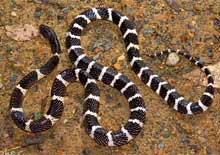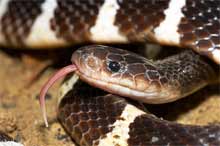|

June 4, 2008
When Joe Slowinski was bitten by a many-banded krait (Bungarus multicinctus), perhaps the deadliest land snake on the planet, in a North Burmese jungle far from medical help, the first thing he did was sit down and have breakfast with his colleagues. (The date: September 11, 2001.) The organizer of the first modern expedition to try to catalog the life-forms of this little-known region, Slowinski was a herpetologist with the California Academy of Sciences whose lifelong passion for venomous snakes had made him a world authority on them—a man who knew and calmly described to his terrified American and Burmese friends in detail what was probably about to happen to him. Such sangfroid is the rule in the brotherhood of snake scientists (a boys’ club only recently infiltrated by a few women), but Slowinski was even more of a cowboy than most. That his confidence in handling snakes bare-handed had verged on carelessness (or something darker) once too often became evident when the bitten hand began to tingle, a sign that the bite had indeed been envenomed with lethal neurotoxin. Soon Slowinski’s respiratory muscles would be paralyzed, and his friends would be locked in a desperate round-the-clock struggle to keep him alive by mouth-to-mouth until a rescue helicopter could arrive. (News of the attacks on the World Trade Center and the Pentagon, which eventually got through, seemed insanely surreal to them.) Bad weather and the suspicion of Myanmar’s xenophobic military regime (a tragic factor this year in the death toll of Cyclone Nargis) conspired to bring a chopper only for Slowinski’s remains, but even aggressive medical intervention might not have availed.

I rarely have time to really read, cover to cover, the books that cross my desk in the course of fact checking, but I couldn’t not read The Snake Charmer, Jamie James’s mesmerizing account of the life and death of Joe Slowinski, which led James all the way to the remote village in Myanmar where Slowinski died—a journey he chronicles in our June issue and in this audio interview (MP3) with Editor in Chief Vittorio Maestro. (Both article and book brought Myanmar and its people to life for me in a way that proved eerily timely when the May 2 cyclone struck soon after.) The fear of snakes may well be instinctive in humans, as it is in monkeys and apes (that link suggests that an “arms race” with snakes may have driven primate evolution), but to have that perverse thing called a mind often means to convert fear into fascination and even attraction, rousing to the challenge to master the thing feared through knowledge and confrontation.
My mother had polio when I was 7—a relatively mild case, luckily, which crippled the calf of one leg but did not paralyze her breathing muscles—and during her recovery, we spent time with her parents in Palm Springs, California, where my grandfather loved to take walks in the desert. I quickly caught this love from him, but someone warned me to watch out for rattlesnakes, and I became obsessed with them. I imagined that they might be under my bed, and I kept reading and rereading a kidsí book about a boy who was bitten by one. (His leg swelled up and turned purple, but he survived. While all snake venom is complex, the venom of
elapids, such as the kraits, cobras, and coral snakes, is predominantly neurotoxic, while the venom of most rattlesnakes—viperids—s mainly hemolytic: it “digests” blood and tissue [warning: link for the strong of stomach]. Indeed, snake venom probably evolved from digestive enzymes.) As it happened, I never even saw a rattler—most venomous snakes would much rather avoid you than attack you—but I did luckily look into the crotch of a palm tree in Florida once before reaching in to feel for “chameleons” (anoles, actually). There was a cottonmouth moccasin folded up in there, and our neighbor, a retired Georgia cattleman, prodded and taunted it out with a penknife and then cut its head off in midair when it struck.
If you feel a tingle down your spine reading such stories, I can heartily recommend James’s book. He tells the story straight, journalistically—with fine scientific chops, by the way—which allows more fateful themes to emerge as if by themselves. Slowinski, 38, was really in love for the first time (with an ornithologist), and was contemplating relaxing his monomaniacal pursuit of knowledge to allow for some other human satisfactions. The author never says this, but you can’t help wondering if a jealous fate forbid it—if his first love wouldn’t let him go. The last words Slowinski was able to communicate to his friends, by writing, were “Let me di—” There’s definitely a movie in it; I’m casting Leo DiCaprio.
Your appetite to read the whole story will only be whetted by reading this account of Slowinski’s death written for Outside Magazine by witness and friend Mark W. Moffett, a Berkeley ecologist–explorer and member of the North Burma expedition who blogs as Doctor Bugs. Still rawer and more affecting is Moffett’s memorial page for Joe, including his e-mail from the field announcing Slowinski’s death and a poem he wrote about Joe and the krait on his way out of Myanmar.
More wonderful stuff:

In addition to those above, these links will give you a peek into a forbidden corner of the planet that teems with unknown life.
- A politically incorrect, British-empire’s-eye view of the Kachin people of northern Burma (related to the Tibetans, but now mostly Baptists, thanks to missionaries), more objectively described here. And here’s a complete ethnography (more than you ever wanted to know, but fascinating to skim) in slightly goofy English.
- Rumors of the elusive—and possibly extinct—pink-headed duck (PDF) of Burma, mentioned in James’s story as a holy grail of international birdwatchers “with a head as pink as bubble gum.”
- Biographical material on Frank Kingdon-Ward (1885–1958), the British botanist-explorer (and quite a fine writer) who was a pioneer of natural history in northern Burma. He’s another of those guys (and gals) who can make you feel like launching a second career as a bio-Indy Jones. I got a copy of Return to the Irrawaddy, the story of his last strenuous trip to Burma in his late 60s, published by Orchid Press, an English-language publisher of books about Asia headquartered in Hong Kong and Bangkok. It is one of the most beautifully and durably made paperback books I’ve ever held in my hands.


(Annie Gottlieb) |
Comments (add yours!)

Return to June home
|



